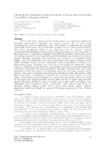Use este identificador para citar ou linkar para este item:
http://www.alice.cnptia.embrapa.br/alice/handle/doc/937392Registro completo de metadados
| Campo DC | Valor | Idioma |
|---|---|---|
| dc.contributor.author | CORREA, L. C. | pt_BR |
| dc.contributor.author | SANTOS, C. A. F. | pt_BR |
| dc.contributor.author | LIMA, G. P. P. | pt_BR |
| dc.date.accessioned | 2017-06-17T00:35:38Z | - |
| dc.date.available | 2017-06-17T00:35:38Z | - |
| dc.date.created | 2012-10-22 | pt_BR |
| dc.date.issued | 2012 | pt_BR |
| dc.identifier.citation | Acta Horticulturae, Leuven, n. 959, p. 103-110, sept. 2012. | pt_BR |
| dc.identifier.uri | http://www.alice.cnptia.embrapa.br/alice/handle/doc/937392 | pt_BR |
| dc.description | Guava and araçá, species of the Psidium genus, are important options for Brazilian agribusiness, especially the former species, due to their fruit characteristics, such as appearance, taste and richness in minerals and phenolic compounds. These fruits can be consumed in natura or in several processed forms. The active germplasm bank is an important tool for genetic resource characterization and plant breeding studies. Sixty guava and ten araçá accessions of the Psidium active germplasm, sampled in 44 different Brazilian regions and grown at Embrapa Semiarid, were chemically and biochemically characterized in order to support breeding programs. The accessions were grown in a randomized block design, with two replications and three plants/plot. The sugar, proteins, soluble solids, titratable acidity, calcium, magnesium, iron and phosphorus contents were determined. Large variations were observed in the analyzed compounds, which could be attributed to the diversity of genotypes and also to the environmental conditions, which affect the plant metabolism. The high variability observed in most parameters of the accessions is an important factor for the improvement of these species. Most guava accessions showed higher titratable acidity and soluble solids than those found in commercial cultivars and, in araçá, these levels were even higher, which makes them promising for commercial exploitation. Moreover, fruits of the guava and araçá accessions present good sources of sugars and minerals. Special attention should be given to some guava and araçá accessions from Maranhão and Pernambuco States, respectively, which showed high levels for titratable acidity, soluble solids, SS/TA ratio, total soluble sugars, calcium, magnesium and iron, should be targets of breeding programs for new Psidium cultivars. | pt_BR |
| dc.language.iso | eng | eng |
| dc.rights | openAccess | eng |
| dc.subject | Psidium spp | pt_BR |
| dc.subject | Composição de frutas | pt_BR |
| dc.subject | Caracterização química | pt_BR |
| dc.subject | Caracterização bioquímica | pt_BR |
| dc.subject | Consumo in natura | pt_BR |
| dc.title | Chemical and biochemical characterization of guava and araçá fruits from different regions of Brazil. | pt_BR |
| dc.type | Artigo de periódico | pt_BR |
| dc.date.updated | 2018-07-09T11:11:11Z | pt_BR |
| dc.subject.thesagro | Goiaba | pt_BR |
| dc.subject.thesagro | Araça | pt_BR |
| dc.subject.thesagro | Fruta Tropical | pt_BR |
| dc.subject.thesagro | Melhoramento Genético Vegetal | pt_BR |
| dc.subject.thesagro | Processamento | pt_BR |
| dc.subject.nalthesaurus | Guavas | pt_BR |
| dc.subject.nalthesaurus | Psidium | pt_BR |
| dc.description.notes | Edição do Proceedings of the III International Symposium on Guava and other Myrtaceae, Petrolina, sept. 2012. | pt_BR |
| riaa.ainfo.id | 937392 | pt_BR |
| riaa.ainfo.lastupdate | 2018-07-09 -03:00:00 | pt_BR |
| dc.contributor.institution | LUIZ CLAUDIO CORREA, CPATSA; CARLOS ANTONIO FERNANDES SANTOS, CPATSA; G.P P. LIMA, UNESP - Botucatu. | pt_BR |
| Aparece nas coleções: | Artigo em periódico indexado (CPATSA)  | |
Arquivos associados a este item:
| Arquivo | Descrição | Tamanho | Formato | |
|---|---|---|---|---|
| CarlosAntonio20121.pdf | 256,56 kB | Adobe PDF |  Visualizar/Abrir |









